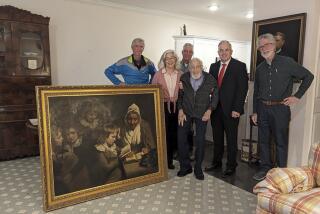PRACTICES PUT CHRISTIE’S REPUTATION ON THE BLOCK
- Share via
NEW YORK — After the last gavel had fallen on a bad night at Christie’s auction house in May, 1981, chairman and auctioneer David Bathurst considered his options and decided to lie.
Only three of eight paintings had been sold, Bathurst announced, for a disappointing total of $10.4 million. “This is high-wire auctioneering,” he said, “and when something falls off the high wire, it falls with a big splash.”
At the time, there were only ripples. The big splash came last week, when Bathurst resigned and surrendered his New York auctioneer’s license. The truth had caught up with him--only one painting was sold that night.
Bathurst’s lie, intended to minimize the damage a bad sale can have on the art market, has been dismissed by Christie’s officials as an isolated case of misjudgment. But others familiar with the auction business say it reflects a system in which competition is overheated and deception is part of the game.
For more than two centuries, Christie’s and arch-rival Sotheby’s have waged genteel war for the art and fortunes of the ruling class. The battleground was historically London, but as art and money shifted to New York, the auction houses followed. Today, Sotheby’s is a privately owned U.S. company, and the busiest offices of both houses are in Manhattan.
The auction houses make their money on both ends of a sale. Buyers are charged 10% of the sale price. Sellers generally pay 10% to 15% of the sale figure, but that commission is negotiable and sometimes is dropped in the competition for a desirable work.
Mystery pervades the most routine art auctions. The most experienced bidders can leave a sale without knowing who bought what, or if anything was even sold.
The reason is the hidden “reserve,” a minimum price agreed upon secretly by the seller and the auctioneer. A piece that fails to fetch the reserve price is said to be “bought in,” and is returned to the seller. Auctioneers do not announce when a work is bought in, but if word gets out, the work is said to be “burned.”
Anthony Ameruso, New York’s commissioner of consumer affairs, will hold hearings this fall on the hidden reserve, which he has attacked as a deceptive trade practice. Auction house officials defend it as a way of protecting against organized bidding. Art dealers denounce it.
Clyde Newhouse, the third generation of his family to run the Newhouse Galleries in Manhattan, recalls an auction in May. Twenty-one times, the auctioneer dropped his hammer and proclaimed paintings sold, but Newhouse later received a list of what had changed hands.
“Only seven were sold, but if you were at that auction, you would be under the impression that all were sold,” he said.
Nor can the audience at an auction necessarily tell who is bidding. Many experienced bidders arrange secret signals with the auctioneer. Others bid by telephone.
Manhattan art dealer Robin Graham, the fifth-generation owner of the Graham Gallery, said he has seen auctioneers call out phony bids when nobody was bidding.
John L. Marion, chairman of Sotheby’s and one of the world’s leading auctioneers, said he sometimes does that to get an auction moving.
“The majority of people wait for the bidding to get on with it to decide whether they are going to get involved,” Marion said. Announcing nonexistent bids “is all part of a very organized marketplace.”
He also defended the hidden reserve. Without it, he said, there would be a danger of dealers joining forces to hold down prices.
Ameruso said the city is likely to consider a requirement that the reserve price be announced in advance, and that auctioneers announce whether a work has been sold or just “bought in.”
He said his office has received numerous complaints about auction house practices, including reports that they sometimes secretly join in bidding on a work.
“This whole practice that we are seeing now seems to reflect that the auction houses maintain artificially supported prices,” he said. “They, in effect, can control the market any way they want.”
Newhouse, who said he generally supports the auction houses, believes they have succumbed to “tremendous hype” since moving to New York.
“They’re hyped up, those houses, to such a peak. . . . It’s grown as the market has grown and the value of pictures has grown and the scarcity of pictures has grown.
“They themselves must have seen the light by now. If it doesn’t come from outside, it must come from inside. They have to get their houses in order.”
More to Read
The biggest entertainment stories
Get our big stories about Hollywood, film, television, music, arts, culture and more right in your inbox as soon as they publish.
You may occasionally receive promotional content from the Los Angeles Times.










